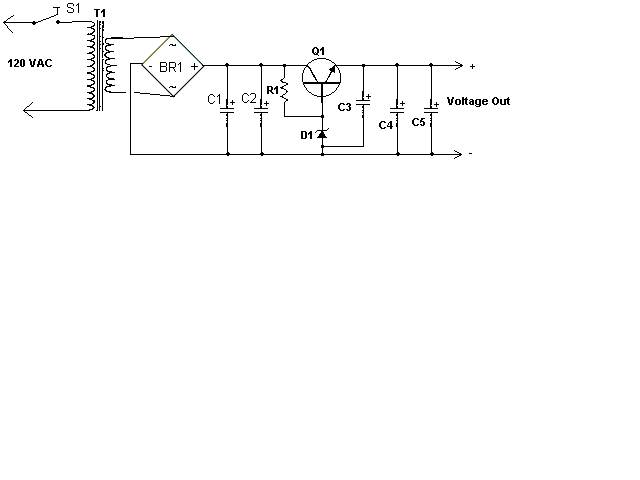Since my page was first posted, I have received a number of emails
asking about a high current power supply. I looked around, but couldn't
find one that was suitable. So, I designed this. It is a linear supply,
which might have a few of you rolling your eyes, but it takes very few
parts, is simple to build and can supply huge currents.
 |
Schematic
|
Parts
|
Part
|
Total Qty.
|
Description
|
Substitutions
|
| R1 | 1 | 680 Ohm 1/4 Watt Resistor |
|
| C1 | 1 | 20,000 - 50,000uF 20-40 Volt Capacitor |
|
| C2, C3 | 2 | 100uF 50 Volt Capacitor |
|
| C4 | 1 | 0.1uF 50 Volt Capacitor |
|
| C5 | 1 | 0.01uF 50 Volt Capacitor |
|
| D1 | 1 | Zener Diode (See Notes) |
|
| Q1 | 1 | 2N3055 Or Other (See Notes) |
|
| T1 | 1 | Transformer (See Notes) |
|
| BR1 | 1 | Bridge Rectifier (See Notes) |
|
| S1 | 1 | SPST 250 VAC 10 A Switch |
|
| MISC | 1 | Case, Line Cord, Heatsink For Q1, Binding Posts For Output |
|
Notes
- D1 should be rated at about one volt higher than then desired output of the supply. A half watt diode will do.
- Q1 can be a transistor similar to the 2N3055. I chose the 2N3055 for it's availability and power handling (150 watts).
- T1 should be about 5 volts higher than the desired output of
the supply, and rated for about one amp more of current. The voltage
overhead is required by the regulator section. The extra current is to
keep the transformer from over heating.
The choice of BR1 will depend on the voltage and current of your
transformer. The rectifier should be rated for 50 volts more than the
transformer, and 5 amps more than the transformer.
- The value of R1 will be smaller when supplying high currents. Expiriment until you get what you need.
- You are going to need to heatsink Q1 and BR1. Use a small PC case style fan unless you are going to run large heatsinks.


No comments:
Post a Comment